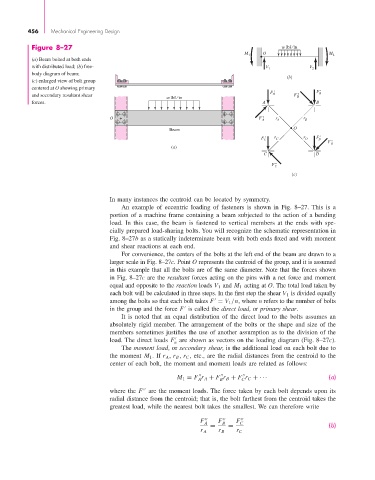Page 481 - Shigley's Mechanical Engineering Design
P. 481
bud29281_ch08_409-474.qxd 12/16/2009 7:11 pm Page 456 pinnacle 203:MHDQ196:bud29281:0073529281:bud29281_pagefiles:
456 Mechanical Engineering Design
Figure 8–27 w lbf ⁄ in
M 1 O M 2
(a) Beam bolted at both ends
with distributed load; (b) free- V V
1 2
body diagram of beam;
(b)
(c) enlarged view of bolt group
centered at O showing primary
and secondary resultant shear F ' A F " B F ' B
w lbf ⁄ in
forces. A B
O + F " A r A r B
O
Beam
F ' C r C r D F ' D
F " D
(a)
C D
F " C
(c)
In many instances the centroid can be located by symmetry.
An example of eccentric loading of fasteners is shown in Fig. 8–27. This is a
portion of a machine frame containing a beam subjected to the action of a bending
load. In this case, the beam is fastened to vertical members at the ends with spe-
cially prepared load-sharing bolts. You will recognize the schematic representation in
Fig. 8–27b as a statically indeterminate beam with both ends fixed and with moment
and shear reactions at each end.
For convenience, the centers of the bolts at the left end of the beam are drawn to a
larger scale in Fig. 8–27c. Point O represents the centroid of the group, and it is assumed
in this example that all the bolts are of the same diameter. Note that the forces shown
in Fig. 8–27c are the resultant forces acting on the pins with a net force and moment
equal and opposite to the reaction loads V 1 and M 1 acting at O. The total load taken by
each bolt will be calculated in three steps. In the first step the shear V 1 is divided equally
among the bolts so that each bolt takes F = V 1 /n, where n refers to the number of bolts
in the group and the force F is called the direct load, or primary shear.
It is noted that an equal distribution of the direct load to the bolts assumes an
absolutely rigid member. The arrangement of the bolts or the shape and size of the
members sometimes justifies the use of another assumption as to the division of the
load. The direct loads F are shown as vectors on the loading diagram (Fig. 8–27c).
n
The moment load, or secondary shear, is the additional load on each bolt due to
the moment M 1 . If r A , r B , r C , etc., are the radial distances from the centroid to the
center of each bolt, the moment and moment loads are related as follows:
(a)
M 1 = F r A + F r B + F r C + ···
C
B
A
where the F are the moment loads. The force taken by each bolt depends upon its
radial distance from the centroid; that is, the bolt farthest from the centroid takes the
greatest load, while the nearest bolt takes the smallest. We can therefore write
F A F B F C
= = (b)
r A r B r C

